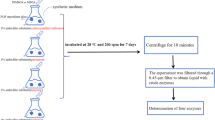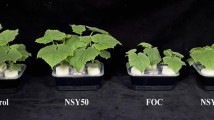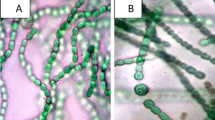Abstract
Fusarium-infected sesame plants have significantly higher contents of amino acids (Asp, Thr, Ser, Asn, Glu, Gly, Ala, Val, Met, Ile, Leu, Tyr, Phe, Lys, His, Try, Arg, and Pro), compared with their respective levels in the healthy control. These higher levels of amino acids induced by Fusarium infection were decreased when Penicillium was co-inoculated with Fusarium. Compared with the control, Fusarium-infected plants showed higher contents of palmitic (8 %), stearic (8 %), oleic (7 %), and linolenic acids (4 %), and lower contents of oil (4 %) and linoleic acid (11 %). Co-inoculation with Penicillium mitigated the Fusarium-induced changes in fatty acids. The total chlorophyll content was lower in Fusarium- and Penicillium-infected plants than in the healthy control. The accumulation of carotenoids and γ-amino butyric acid in Fusarium-infected plants was slightly decreased by co-inoculation with Penicillium. Sesamin and sesamolin contents were higher in Penicillium- and Fusarium- infected plants than in the control.
Purpose of work:
To clarify the mechanism of the biocontrol effect of Penicillium against Fusarium by evaluating changes in primary and secondary metabolite contents in sesame plants.





Similar content being viewed by others
References
Arnon DI (1949) Copper enzyme in isolated chloroplasts and polyphenoloxidase in Beta vulgaris. Plant Physiol 24:1–15
Bates LS, Waldren RP, Teare ID (1973) Rapid determination of free proline for water stress studies. Plant Soil 39:205–207
Bertamini M, Nedunchezhian N, Tomasi F, Grando S (2002) Phytoplasma [Stolbur subgroup (Bois Noir-BN)] infection inhibits photosynthetic pigments, ribulose-1, 5-biphosphate carboxylase and photosynthetic activities in field grown grapevine (Vitis vinifera L. cv. Chardonnay) leaves. Physiol Mol Plant Pathol 61:357–366
Bouche N, Fromm H (2004) GABA in plants: just a metabolite? Trends Plant Sci 9:110–115
Brauc S, Vooght ED, Claeys M, Hofte M, Angenon G (2011) Influence of over-expression of cytosolic aspartate aminotransferase on amino acid metabolism and defense responses against Botrytis cinerea infection in Arabidopsis thaliana. J Plant Physiol 168:1813–1819
Choudhary DK (2011) Plant growth promotion (PGP) activities and molecular characterization of rhizobacterial strains isolated from soybean (Glycine max L. Merril) plants against charcoal rot pathogen, Macrophomina phaseolina. Biotechnol Lett 33:2287–2295
Christie WW (2003) Preparation of derivates of fatty acids. Lipid analysis: isolation, separation and structural analysis of lipids, 3rd edn. PJ Barnes and Associates, Bridgwater, pp 205–225
Creelman RA, Mulpuri R (2002) The oxylipin pathway in Arabidopsis. The Arabidopsis book. American Society of Plant Biologists, Rockville, pp 1–24
El-Shazly MS, Abdul-Wahid OA, El-Ashry MA, Ammar SM, El-Barmawy MA (1999) Evaluation of resistance to Fusarium wilt disease in sesame germplasm. Int J Pest Manag 45:207–210
Fabro G, Kovacs I, Pavet V, Szabados L, Alvarez ME (2004) Proline accumulation and AtP5CS2 gene activation are induced by plant-pathogen incompatible interactions in Arabidopsis. Mol Plant Microbe Interact 17:343–350
Hruz T, Laule O, Szabo G, Wessendorp F, Bleuler S, Oertle Widmayer P, Gruissem W, Zimmermann PL (2008) Genevestigator V3: a reference expression database for the meta-analysis of transcriptomes. Adv Bioinformatics. doi:10.1155/2008/420747
Janzen DJ, Allen LJ, Macgregor KB, Bown AW (2001) Cytosolic acidification and γ-aminobutyric acid synthesis during the oxidative burst in isolated Asparagus sprengeri mesophyll cells. Can J Bot 79:438–443
Jeng KCG, Hou RCW (2005) Sesamin and Sesamolin: nature’s therapeutic lignans. Curr Enzym Inhib 1:11–20
Jia M, Keutgen N, Matsuhashi S, Mitzuniwa C, Ito T, Fujimura T, Hashimoto S (2001) Ion chromatographic analysis of selected free amino acids and cations to investigate the change of nitrogen metabolism by herbicide stress in soybean (Glycine max). J Agric Food Chem 49:276–280
Khan AL, Hamayun M, Radhakrishnan R, Waqas M, Kang SM, Kim YH, Shin JH, Choo YS, Kim JG, Lee IJ (2012) Mutualistic association of Paecilomyces formosus LHL10 offers thermotolerance to Cucumis sativus. Antonie Van Leeuwenhoek 101:267–279
Lichtenthaler HK (1987) Chlorophylls and carotenoids: pigment of photosynthetic biomembranes. Method Enzymol 148:350–382
Silveira JAG, Melo ARB, Viegas RA, Oliveira JTA (2001) Salinity-induced effects on nitrogen assimilation related to growth in cowpea plants. Environ Exp Bot 46:171–179
Trepanier M, Becard G, Moutoglis P, Willemot C, Gagne S, Avis TJ, Rioux JA (2005) Dependence of arbuscular-mycorrhizal fungi on their plant host for palmitic acid synthesis. Appl Environ Microbiol 71:5341–5347
Whiteside MD, Garcia MO, Treseder KK (2012) Amino acid uptake in arbuscular mycorrhizal plants. PLoS One 7(10):e47643
Xue HQ, Upchurch RG, Kwanyuen P (2006) Ergosterol as a quantifiable biomass marker for Diaporthe phaseolorum and Cercospora kikuchii. Plant Dis 90:1395–1398
Zafari S, Niknam V, Musetti R, Noorbakhsh SN (2012) Effect of phytoplasma infection on metabolite content and antioxidant enzyme activity in lime (Citrus aurantifolia). Acta Physiol Plant 34:561–568
Acknowledgments
The authors wish to thank National Institute of Crop Science, Rural Development Administration, Republic of Korea for financial assistance from Post doctoral Fellowship Program (2012).
Author information
Authors and Affiliations
Corresponding author
Rights and permissions
About this article
Cite this article
Radhakrishnan, R., Pae, SB., Shim, KB. et al. Penicillium sp. mitigates Fusarium-induced biotic stress in sesame plants. Biotechnol Lett 35, 1073–1078 (2013). https://doi.org/10.1007/s10529-013-1177-7
Received:
Accepted:
Published:
Issue Date:
DOI: https://doi.org/10.1007/s10529-013-1177-7




